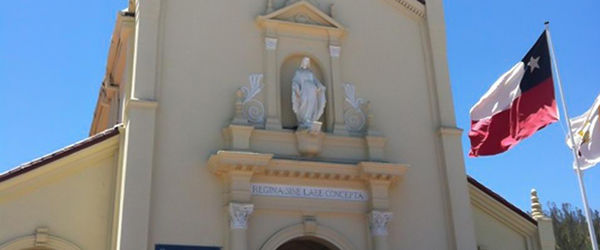On the 72nd anniversary of the dedication of the chapel at St. John’s Seminary, the community also celebrated the completed restoration of three oratory paintings with a special ceremony and blessing of the art.The oil-on-canvas paintings — “Christ the Redeemer,” “Our Lady of Guadalupe” and “Death of St. Joseph” — were done by famed artist Ettore (Hector) Serbaroli and have hung in the Camarillo seminary’s oratory since the early 1940s. Nearly seven decades of dirt, candle smoke residue and even a bit of water damage from a roof leak had obscured the true vibrancy of the art works. The restoration process was done by a team of highly skilled artists/conservators led by Patty West, director of the South Coast Fine Arts Conservation Center in Santa Barbara. The work included gentle removal of the layers of dirt and residue, repairing of damaged paint, and then application of an acrylic varnish to protect the oils. “We had the eyes to see through the dirt to what is there,” said West, whose conservancy has prior experience with Serbaroli works. “Our job was to bring these pieces back to life.”The restoration project was made possible by $25,000 in donations, raised by the seminary specifically for this purpose. Donors included Msgr. Douglass Saunders, retired pastor of St. Maria Goretti Church in Long Beach, and his mother.As the seminary prepared to celebrate the anniversary of the dedication of its chapel on October 8, seminarians and members of the community gathered in the oratory for a pre-Mass blessing of the newly-restored art. Msgr. Craig Cox, seminary rector, thanked West and her group of artists, and then prayed a special blessing over each painting.“It was an honor to be able to do this for the seminary,” said Cindy Golson, one of the artists who assisted with the restoration. During his homily, Msgr. Cox reminded attendees of the importance of sacred places and sacred art in the spiritual lives of the faithful“Things physical mean a great deal to us because we are embodied spirits; as such: places, sounds, tastes all matter tremendously,” Msgr. Cox said. “These are reasons why Catholics cherish the arts.“The beauty of our surrounding reminds us of the beauty of God, and also reminds us of who we are. For 72 years people have filled this building and that is what makes this place holy: the people who passed through and continue to do so.”Msgr. Cox pointed out that no matter how beautiful a building is, it is that place deep within the person that is most precious — the place where Christ dwells. About the artist…Born in Rome on Jan. 7, 1881, Ettore (Hector) Serbaroli lived just shy of 71 years and left a treasure of art that lives on today — in film, in famous buildings and galleries, and in several local Catholic parishes in addition to St. John’s Seminary.As a youth he studied with master painters in Rome, earning awards that eventually led to working with Cesare Maccari, a famous Italian muralist. At age 26 he was commissioned to create murals in the Teatro Nacional (now known as The Palacio de las Belas Artes) in Mexico City. He remained in Mexico until the Mexican revolution, then moved to San Francisco with his wife to work on oil paintings for the Panama-Pacific International Exposition.During his time in the bay area, Serbaroli was approached to adorn the ceilings of the Hearst Castle and to restore some of Hearst’s other antique artworks. In 1927 he met writer Adela Rogers St. John. It was through her that Serbaroli came to Hollywood to begin work in the motion picture industry, creating sketches, designing sets, murals and portraits that would be integral in countless films of the 1930s and ’40s at studios including Warner Bros., RKO Pictures, 20th Century Fox and Paramount.It was during the 1940s that Serbaroli’s focus turned to sacred art. He began working on paintings and murals for churches, among them, the three oil-on-canvas paintings that hang in the oratory of St. John’s Seminary. His works can also be found in several other archdiocesan churches, including St. Andrew (Pasadena), Good Shepherd (Beverly Hills), Holy Family (South Pasadena) and St. Monica (Santa Monica). Serbaroli died in December of 1951 and is buried at Calvary Cemetery in Los Angeles.…and his daughterAn acclaimed artist in her own right, Hector’s daughter Judy (1914-79) was known to laity and clergy alike as “Miss Gold Leaf,” derived from her skill in applying layers of gold leaf to the reconstructed reredos in the Chapel of Queen of Angels High School Seminary in Mission Hills.Msgr. Francis Weber, archdiocesan archivist emeritus, notes in his book, “Encyclopedia of California’s Catholic Heritage,” that Judy Serbaroli — a graduate of Immaculate Heart High School — had an encyclopedic knowledge of art history that “proved exceedingly useful for portraying the rich symbols of Catholic tradition.”Judy assisted her father in painting works at Cathedral Chapel, the Rosary Chapel of Immaculate Conception (Los Angeles) and St. Ignatius (Highland Park) as well as Holy Family and St. Andrew (mentioned above). Perhaps her “culminating masterpiece,” says Msgr. Weber, was her work at St. Charles Borromeo Church, North Hollywood, where “she designed the church and painted the life-size Stations of the Cross in tones of sepia.”At St. John’s Seminary, says Msgr. Weber, Judy was “influential” in suggesting the ornamentation and color scheme for St. James Chapel in the former seminary college. At her funeral Mass in 1979, Cardinal Timothy Manning described her as “an inspiration and a guide in the development of ecclesiastical art in the Archdiocese of Los Angeles.”{gallery width=100 height=100}gallery/2012/1102/sbartwork/{/gallery}

